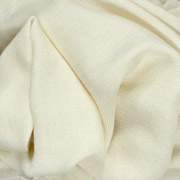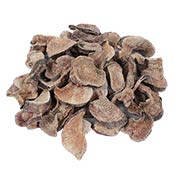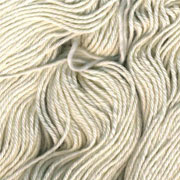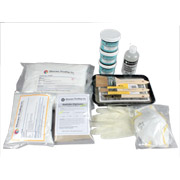Ingredients needed to make the stock solution
- 1 part indigo
- 2 parts pickling lime (calcium hydroxide)
- 3 parts fruit sugar (fructose) - henna can also be used
- A 1 quart Mason jar and lid
For example you can use 1 spoonful of indigo, 2 spoonfuls of pickling lime and 3 spoonfuls of fruit sugar. Using the entire packet of indigo will make a very strong vat. Use a larger container such as a bucket to make the stock solution with amounts larger than a few spoonfuls of indigo.
The purpose of the fruit sugar is to remove excess oxygen in the indigo solution. The purpose of the pickling lime is to make the vat alkaline and help dissolve the indigo
Making the Stock
- Combine indigo with a little warm water to make a paste in the Mason jar. If using larger amounts of indigo (more than three heaping tablespoons, use a larger container such as a bucket)
- Add 1 cup of very hot water (around 140-170°F) and stir well. Add the fruit sugar. Stir to dissolve.
- Add the lime and stir well to incorporate. It may be slightly lumpy at first but keep stirring. Gradually add 1-2 cups of water, leaving about 2 inches of headspace from the top of the jar. Stir well and then allow the mixture to settle. The solution will be dark blue.
- Watch for the first bubble. This means fermentation is starting. The solution will begin to ferment and change color. Sometimes it becomes quite murky green and other times it will be nearly a reddish brown. You will see a clear line of sediment at the bottom of the jar, which is normal.
The solution is ready when the solution has turned from a dark greenish blue and is now either greenish yellow, brownish yellow, or sometimes even reddish yellow, depending on the variety of indigo you are using. You should see a cluster of bubbles on the surface of the jar called the indigo flower and see a metallic coppery scum across the surface of the solution.
If the solution is not changing color, stir the deposit at the bottom of the jar, and place the jar in a water bath and carefully heat it to 140°F. Continue stirring the deposit every 30 minutes or so until the jar has the developed the indigo flower and the coppery scum. Meanwhile, prepare your dye pot using a clean dye kettle or a 5 gallon plastic paint bucket. Fill it about 2/3 full with hot water (140°F).
Making the Vat
Once the jar of indigo solution is ready, stir it and then add it to the dye pot filled with very warm water. The vat should have a murky, yellowish color. Let the dye pot sit for about 15 minutes. Again, look for the indigo flower and coppery scum developing. The vat is ready when it has turned greenish yellow as noted below. If it is dark blue, add more fruit sugar to continue the reducing chemical reaction. If after 15 minutes it does not turn yellow-green, add more calcium hydroxide to increase alkalinity of the vat. You may also heat the vat to 140°F to speed the reduction process.
Dipping the fibers
- Soak the items you wish to dip in water for at least one hour. If you are doing shibori patterning, soak the items after you have tied them. Have fibers wet but not dripping from their soaking bath.
- Dip the wetted out fibers into the indigo bath and hold under the surface of the vat rotating the goods gently. Try not to stir bubbles into the vat.
- Keep the fibers in the vat for 5-10 minutes, then quickly remove and allow the excess indigo to drip off into a plastic bucket. The fiber will emerge from the vat a yellowish green color, and then begin to turn blue before your eyes. This is the indigo oxidizing. Once the fiber is completely blue it is oxidized.
The best way to deepen indigo color is to dip multiple times, increasing the dipping time for each round that you dip. For example you can dip for 5 minutes, oxidize, then 10 minutes, oxidize, then 20 minutes, oxidize, and so forth and build up a very dark blue shade. Dip additional times until the color is about 2 shades darker than what you want, making sure the check that the vat is still yellow-green. If the vat liquid is turning blue, re-balance the vat using the procedure below before resuming dipping.
The suggested dipping strategy is as follows:
- For very pale shades of blue use only a portion of the indigo stock solution in the jar and dip for 30-60 seconds two or three times.
- For medium shades, use the half the amount of indigo stock solution and dip multiple times for 1 minute each until you reach the desired shade.
- For darker shades, use the entire amount of indigo stock solution and dip multiple times and increase the amount of time in the vat for up to 30 minutes per dip.
Balancing the Vat
If the vat starts reverting to its blue state, add about a tablespoon of pickling lime (calcium hydroxide) and stir gently to incorporate. Then add 2 tablespoons of fruit sugar. The vat should start to reduce and become yellowish. Again, gentle heat up to 140°F may help revive it faster.
Storing or Disposing the Vat
When you are done dipping, you may keep your indigo vat covered and replenish it the next time you want to dip. To replenish your vat, follow the instructions above for Balancing the Vat. If you have extra stock solution, you may warm it up and add it to the vat and then rebalance it with fruit sugar and pickling lime.
To dispose of the vat add 1-2 cups white vinegar, stir and dump it down the drain. Flush with clear water.
Washing the Fibers
When the fibers are completely blue with no yellow or green areas, the indigo has oxidized. You may continue to air the fibers for up to 24 hours. Wash the fibers with a mild soap and warm water to remove excess indigo. Rinse the fibers in cool water until the water runs clear. Lay flat or hang to dry out of direct sun.

























